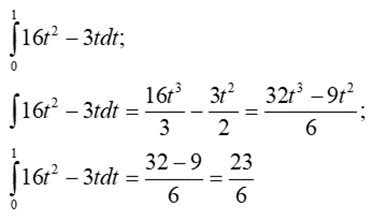Here’s a problem (5.2.2, p. 58) from Lang’s “A Second Course in Calculus”:
Compute the line integral of the vector field over the indicated curve. (x, y, xz - y) over the line segment from (0, 0, 0) to (1, 2, 4).
x(t) = x0 + (x1 – x0)t
y(t) = y0 + (y1 – y0)t
z(t) = z0 + (z1 – z0)t
Here, t varies between 0 and 1. When t is 0, you get (0, 0, 0); when t is 1, you get (1, 2, 4). Let’s get the parametrization now:
x(t) = 0 + (1 - 0)t = t
y(t) = 0 + (2 - 0)t = 2t
z(t) = 0 + (4 - 0)t = 4t
Therefore,
r(t) = (t, 2t, 4t)
r’(t) = (1, 2, 4)
Now, we will substitute t for x, 2t for y, and 4t for z in the vector field:
F(r, t) = (x, y, xz - y)
F(r, t) = (t, 2t, 4t2 – 2t)
Next, we have to take the dot product of the vector field along the curve with the derivative of the parametrization:
F(r(t)) * r’(t)
(t, 2t, 4t2 – 2t) * (1, 2, 4)
Using the definition of the dot product, we get:
t + 4t + (4t2 – 2t)(4)
5t+ 16t2 – 8t
16t2 – 3t
We can now compute the integral of this dot product over the interval [0, 1].

Therefore, the answer is 23/6.
BridgeText can help you with all of your statistical analysis and mathematics needs.





